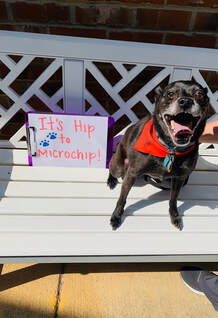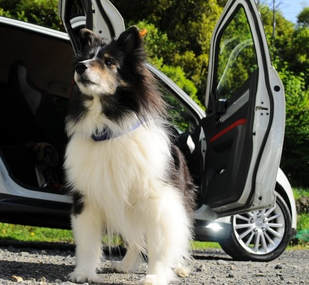Laurie Anne Walden, DVM Photo by Anatolii Kozhukhar on Unsplash Photo by Anatolii Kozhukhar on Unsplash Many dogs and cats experience fear, anxiety, and stress at the veterinary clinic. Their anxiety often begins before they even arrive at the clinic, especially if they associate pet carriers and car rides with the clinic. Previsit antianxiety medications for pets can make clinic visits easier and safer for these pets, their owners, and clinic staff. These are some of the benefits of previsit medications for anxious pets:
Previsit medications have benefits for pet owners and clinic staff members too. Being the caretaker of an anxious and fearful pet isn’t easy, so previsit medications for pets can reduce everyone’s stress levels. For clinic staff members, managing patients’ clinic anxiety reduces the risk of injury and decreases workplace stress (we love animals too and don’t want to cause them distress). How to Know if Your Pet Needs Previsit Medications Previsit medications aren’t just for aggressive animals. Pets with more subtle signs of stress are scared too, and they deserve help for their anxiety just as much as animals that can’t be handled without full sedation. If your pet shows obvious signs of fear at the clinic, you probably already know that your pet would benefit from previsit medications. But maybe your pet’s signs are not as noticeable and you’re a little surprised when your veterinarian recommends medications. Dogs and cats show anxiety and fear with a range of behaviors and body language cues. Anxious and fearful dogs and cats tend to start with subtle behaviors like lip licking or freezing. If the scary thing doesn’t go away—or tries to draw a blood sample—the behavior can escalate to aggression. Dogs and cats that are anxious at the veterinary clinic can show these signs:
How to Use Previsit Medications Previsit medications work best if they’re used along with training and positive reinforcement. For example, a cat can make positive associations with the cat carrier if the carrier is left out all the time as part of the normal household furniture, sometimes with yummy treats inside, instead of appearing only when the cat is going to the clinic. Veterinarians choose previsit medications according to the needs and medical condition of the individual patient. Some of the drugs commonly prescribed for situational (short-term) anxiety are gabapentin, trazodone, and clonidine. Motion sickness contributes to anxiety, so pets might also receive antinausea medication. Some of these medications can cause sedation, but the main goal is anxiety reduction, not sedation. Previsit medications are timed to have maximum effect at the time of the clinic visit. They need to take effect before the pet experiences any stress. Most of these medications are given at least 1 to 2 hours before the clinic visit; sometimes a loading dose is also given the night before. They typically last for up to 8 hours, although the duration can vary. Because individual animals respond differently to these medications, giving a trial dose can be very helpful. If you use a trial dose, tell your veterinarian how long it took for the medication to take effect, how the medication affected your pet’s behavior, whether your pet had adverse effects like vomiting or excessive sedation, and how long the medication’s effects lasted. For some dogs and cats, previsit medications aren’t enough to overcome their fear. These pets might also need a sedative injection at the clinic. For these pets, previsit medications given at home make the sedative injection easier for the pet (and staff) and can also reduce the dose of injectable drug. Image source: https://unsplash.com/photos/a-white-cat-sitting-inside-of-a-cage-B-_SyRxv2So Laurie Anne Walden, DVM 
Photo by Ian Badenhorst on Unsplash Laurie Anne Walden, DVM  Microchips are a type of permanent identification that helps families reunite with lost pets. Pets should also have visible forms of identification like collar tags, but microchips can’t be pulled off by accident and are an important backup. Microchips are also required in some situations, like transporting animals. Microchips connect owners to lost pets only if the owner’s contact information is registered in a microchip database. The United States does not have a central microchip registry. Microchip manufacturers and pet recovery services maintain their own databases. It’s essential to keep your contact information up to date in your pet’s microchip database. If you’re not sure where your pet’s microchip is registered, enter the microchip number in the American Animal Hospital Association microchip lookup tool: http://www.petmicrochiplookup.org/ If you don’t know the microchip number, your veterinarian’s office can scan your pet if the number is not already entered in your pet’s medical record. What Are Microchips? Microchips are radiofrequency identification transponders about the size and shape of a grain of rice. Microchips are implanted under the skin. In dogs and cats, they are implanted between the shoulder blades. You can’t usually feel a microchip under your pet’s skin, but you can see it on an x-ray image. A microchip is not a GPS device and can’t be used to track your pet. How Are Microchips Implanted? A microchip is injected under the skin through a needle, similar to the way a vaccine is injected (although the needle is a bit larger). Animals do not need anesthesia during microchip insertion. Your veterinarian can implant a microchip during an office visit. How Does Scanning Work? Shelters and veterinary clinics routinely scan stray dogs and cats for microchips. If the animal has a microchip and the owner’s information in the database is accurate, the staff can contact the owner. A microchip scanner emits a low-power radiofrequency signal that activates the microchip. When a microchip scanner passes over a microchip, the chip transmits a number that the scanner displays on a screen. The number is unique to that microchip, so once you’ve registered it, it’s also unique to your pet. Microchip manufacturers around the world make microchips that use different radiofrequencies. Not all scanners detect all microchip frequencies. Universal scanners read multiple frequencies. Microchips that meet the International Standards Organization (ISO) global standard transmit a specific radiofrequency that can be read by an ISO-standard scanner. Some countries require ISO-compliant microchips for imported animals. Are Microchips Safe? The benefits of microchipping are generally far greater than the potential risks. Adverse reactions to microchips are rare. Animals could bleed a little or have mild, short-lived discomfort at the injection site. Infection and swelling at the injection site are possible but not common. Microchips can theoretically cause inflammation that leads to cancer, but almost all reports of cancer near a microchip implantation site have been in laboratory rodents. Only a few cases in cats and dogs have been reported, and in most it was not clear if the cancer was linked to the microchip. Are Microchips Reliable? It’s possible for an animal to have a microchip that isn’t found on a scan. A microchip might use a different radiofrequency than the scanner can detect (if the scanner isn’t universal). Microchips occasionally migrate under the skin, usually to the side of the shoulder or front leg. People scanning for microchips typically scan a wide area of the body for this reason. And a microchip might not work at all (or stop working). Ask your veterinarian to check your pet’s microchip at the next clinic visit. For more information, see Microchipping of Animals FAQ on the American Veterinary Medical Association (AVMA) website. The AVMA Microchipping of Animals backgrounder page was also a source for this article. Laurie Anne Walden, DVM  1. Never leave an animal in a parked car in warm weather. Pets can die of heat stroke if they’re left for even a short time in a hot car. Heat exhaustion isn’t only a summertime risk. On sunny days, a car interior can become dangerously hot even if it’s pleasantly warm outside. The temperature inside a parked car can increase by nearly 20°F in only 10 minutes. When the outside temperature is 70°F, a car interior may reach 113°F in an hour. If it’s 95°F outdoors, the temperature inside a car can climb to 114°F in 10 minutes. Cracking the windows open has no effect on the temperature inside a parked car. Signs of heat exhaustion and heat stroke include panting, dark red gums, rapid heart rate, vomiting, and difficulty breathing. Heat stroke can be fatal. Brachycephalic (flat-faced) animals are especially at risk. Read more about heat stroke here. 2. Keep your pet restrained. Just like children, pets are safest in cars when they’re securely restrained. Seat belt harnesses and crates keep pets from becoming airborne during hard braking or being thrown out of the car in a collision. Pets riding in laps can be crushed by a person’s body or an inflating airbag. Unsecured animals can also injure people in the car if they become projectiles during a crash. Animals that are loose in cars can also distract the driver, increasing the risk of accidents. Pets may worm their way into a driver’s lap or line of vision, and those that make their way into the footwell interfere with the foot pedals. Dogs riding in truck beds should be confined in a ventilated crate that is protected from the weather and attached to the truck. Dogs should never ride in a truck bed unrestrained or secured only by a leash; they can be killed or severely injured if they jump or are thrown out. If possible, give your pet time to become familiar with the restraint (harness or carrier) before using it on a road trip. Start with short rides that end in something fun to help your pet build positive associations with the restraint. 3. Don’t let your dog ride with its head out of the window. A dog sticking its head out of a car window with its ears flapping in the breeze may look cute, but this is not a safe way for dogs to ride. Dogs can sustain eye and head injuries from flying debris. A dog that is able to get its head or other body parts out of a window is also not safely restrained. 4. Manage anxiety and nausea on car trips. Stress and motion sickness are not as dangerous for pets as heat stroke or being ejected from a moving vehicle, but managing these common problems makes a trip easier for everyone. (And a dog vomiting all over the upholstery is certainly a distraction for the driver.) Both anxiety and motion sickness can cause vomiting, so discuss your pet’s symptoms with your veterinarian to determine the best treatment approach. Two things you can try are withholding food for a few hours before travel and starting with very short rides. Pets with motion sickness may experience less nausea with an empty stomach—at the very least, cleanup will be easier if they do vomit. Pets with anxiety may need to begin by just sitting with you for a few minutes in the parked car. Over time, with patience and positive reinforcement, you can begin driving them around the block and building up to longer rides. One of my own dogs is much calmer in the car if he’s in the crate that he likes to nap in at home (in this case, the crate is both a restraint and a safe, familiar space). Antianxiety and antinausea medications help many animals travel more comfortably. The choice of medication depends on the symptoms and the cause of the problem. Talk to your veterinarian if your pet continues to have signs of nausea or stress in the car. 5. If in doubt, leave your pet at home. Not all pets like to ride in the car, and not all destinations welcome animals. Some trips, like visits to the veterinary clinic, are unavoidable. For other excursions, consider leaving your pets safely at home if they don’t enjoy car rides and don’t have to go with you. Photo by n-k Laurie Anne Walden, DVM What would you do with your pets if you had to evacuate? Hurricanes, tornadoes, and winter storms can affect any part of North Carolina. Fires and other unexpected events can also displace families with little or no warning. Plan ahead so you can take your pets with you. Don't leave them behind except as a last resort (and never leave them chained outdoors). Bring pets indoors at the first warning of a storm. You might need to be able to find them quickly. Pet identification
Pet-friendly housing Emergency shelters might not be able to accept animals. Locate places you can go with your pets in advance. Consider alternatives to public shelters:
Pet transport Have a leash, harness, or carrier handy for every pet in your household. Be sure you have as many cat carriers as cats. Secure and comfortable crates (large enough to stand up and turn around in) are useful for transporting dogs and might be required at co-located shelters. Emergency kit Prepare an emergency kit and consider keeping a larger set of supplies at home in case you have to shelter in place (for example, during an ice storm). The Federal Emergency Management Agency (FEMA) recommends including these items in a pet emergency kit:
Backup caregivers Discuss your evacuation and pet care plans with friends, neighbors, or relatives. Try to arrange to have someone care for your pets or evacuate them if you can't. A study of an evacuation after a chemical spill in Wisconsin showed that 60% of dogs and cats were not evacuated. Cats were only half as likely as dogs to be evacuated. Failure to evacuate cats was associated with not having cat carriers. Planning for evacuation in advance will help you avoid this kind of logistical problem. For more information The recommendations in this article are from FEMA (also see this brochure [PDF]), the Humane Society of the United States, the American Society for the Prevention of Cruelty to Animals, NC State University, the NC Department of Public Safety, and the NC Department of Agriculture [PDF]. August 31, 2017 Photo by Iler Stoe |
AuthorLaurie Anne Walden, DVM Categories
All
Archives
June 2024
The contents of this blog are for information only and should not substitute for advice from a veterinarian who has examined the animal. All blog content is copyrighted by Mallard Creek Animal Hospital and may not be copied, reproduced, transmitted, or distributed without permission.
|
- Home
- About
- Our Services
- Our Team
-
Client Education Center
- AKC: Spaying and Neutering your Puppy
- Animal Poison Control
- ASPCA Poisonous Plants
- AVMA: Spaying and Neutering your pet
- Biting Puppies
- Boarding Your Dog
- Caring for the Senior Cat
- Cats and Claws
- FDA warning - Bone treats
- Force Free Alliance of Charlotte Trainers
- Getting your Cat to the Vet - AAFP
- Holiday Hazards
- How To Feed Cats for Good Health
- How to Get the Most Out of your Annual Exam
- Indoor Cat Initiative - OSU
- Introducing Your Dog to Your Baby
- Moving Your Cat to a New Home
- Muzzle Training
- Osteoarthritis Checklist for Cats
- What To Do When You Find a Stray
- Our Online Store
- Dr. Walden's Blog
- Client Center
- Contact
- Cat Enrichment Month 2024
|
Office Hours
Monday through Friday 7:30 am to 6:00 pm
|
Mallard Creek Animal Hospital
2110 Ben Craig Dr. Suite 100
|
Site powered by Weebly. Managed by IDEXX Laboratories

 RSS Feed
RSS Feed